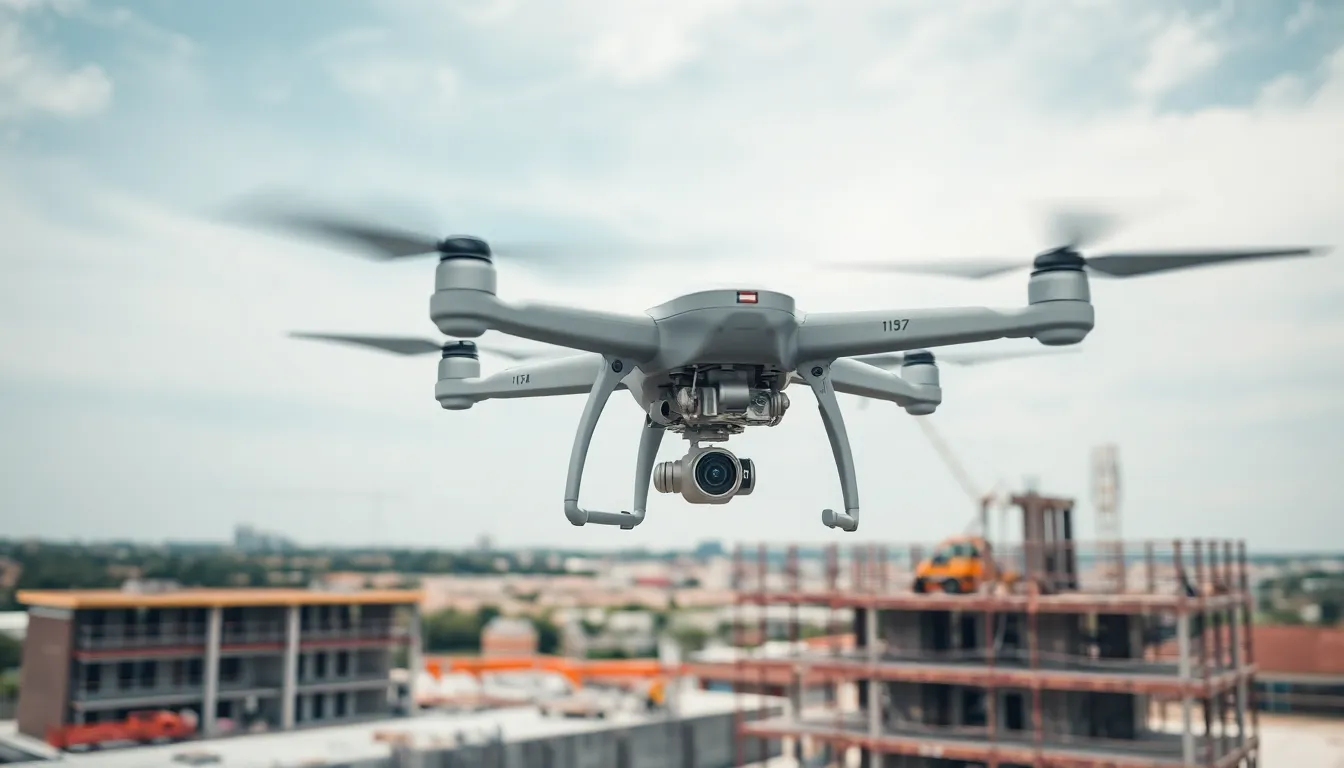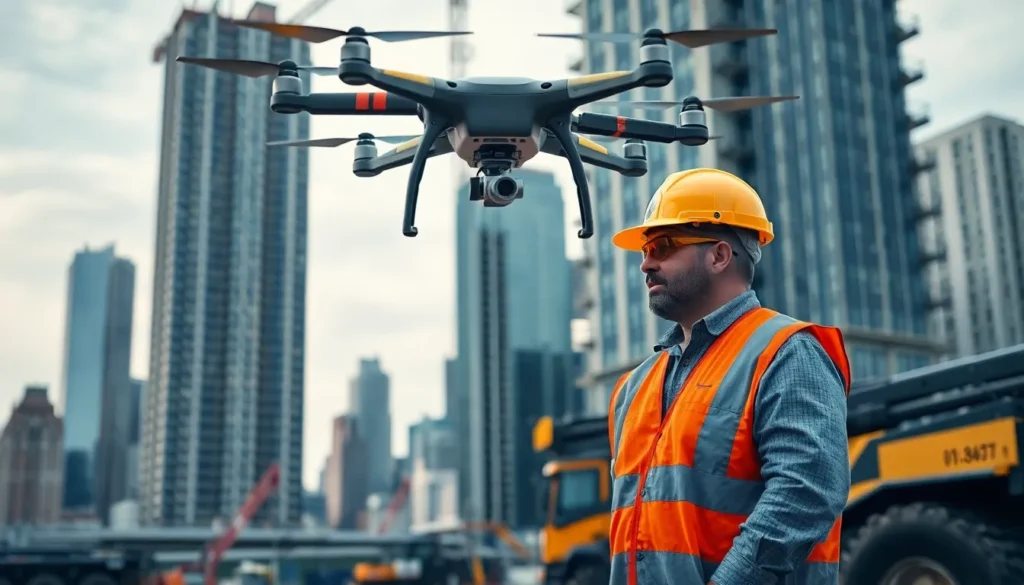In a world where even your pizza can be delivered by a flying robot, it’s no surprise that drones are taking the inspection industry by storm. Gone are the days of risking life and limb to check out hard-to-reach places. Now, with a trusty drone in hand, inspectors can soar high and see everything from rooftops to bridges without breaking a sweat—or a ladder.
Table of Contents
ToggleOverview of Drones for Inspection
Drones play a transformative role in the inspection industry, improving safety and efficiency. Utilization of unmanned aerial vehicles (UAVs) allows inspectors to reach challenging environments without direct human risk. Common applications span various sectors, including construction, energy, and telecommunications.
In construction, drones capture high-resolution images of building sites, enabling real-time monitoring of progress. They assist in identifying structural issues early, which can save time and reduce costs. Inspectors use drones to map terrain and plan projects more effectively.
Energy companies implement drones to inspect infrastructure such as wind turbines and power lines. These UAVs can cover vast areas quickly, detecting faults before they lead to outages. Regular inspections through drones enhance system reliability and compliance with safety regulations.
Telecommunications benefit from drone inspections by assessing cell towers and antennas. Aerial views from drones facilitate detailed evaluations, identifying maintenance needs without requiring extensive setups or scaffolding. The efficiency gained leads to reduced downtime and quicker repairs.
Cost-effectiveness is another key advantage of using drones for inspections. Traditional methods often involve labor-intensive setups and costly equipment. Drones reduce these costs by minimizing manual labor and enabling faster data collection.
Safety emerges as a critical factor in the adoption of drones. Reducing reliance on ladders, scaffolds, and lifts lowers the risk of accidents. In hazardous environments, drones offer a safer alternative, enhancing overall workplace safety.
Adopting drone technology streamlines inspection processes, ultimately revolutionizing industry standards. Data collected from UAVs often leads to more accurate assessments. Investors recognize the potential of drones to optimize operations and improve decision-making in inspections.
Key Features of Drones for Inspection

Drones designed for inspection come equipped with advanced features that enhance their functionality and efficiency. These attributes are crucial for conducting thorough evaluations across various sectors.
Camera Quality
High-resolution cameras represent one of the most important features of inspection drones. They capture sharp images and videos, providing detailed visuals of structures or landscapes. Many models utilize 4K resolution technology, enabling clear identification of issues like cracks or wear. Thermal imaging capabilities also enhance inspections, allowing for detection of heat irregularities in electrical systems or building envelopes.
Flight Time
Extended flight time plays a vital role in inspection efficiency. Many inspection drones can operate for 20 to 45 minutes per charge, depending on the payload and conditions. This duration allows thorough coverage of expansive areas without constant recharging. Long-range capabilities enhance operational efficiency, enabling inspectors to scan large infrastructures like bridges or pipelines in a single flight.
GPS and Navigation
Accurate GPS and navigation systems are essential for effective drone inspections. These systems allow drones to follow pre-programmed flight paths with precision. Real-time positioning data ensures that teams can access and analyze specific areas systematically. Furthermore, advanced navigation features facilitate safe operation in complex environments, minimizing the risk of collisions and maximizing inspection quality.
Applications of Drones for Inspection
Drones play a vital role in various inspection applications across multiple industries. They enhance efficiency, reduce risks, and improve accuracy in assessments.
Infrastructure Inspections
Drones excel in infrastructure inspections, providing safe access to hard-to-reach structures. They collect high-resolution images to identify structural issues in real-time. Bridges and rooftops benefit especially from this technology. Inspectors can monitor conditions without the dangers associated with ladders or scaffolding. Using drones, engineers conduct detailed evaluations quickly, ensuring compliance with safety regulations. Data gathered also aids in maintenance planning, allowing for timely repairs and reducing long-term costs.
Agricultural Inspections
In agriculture, drones become invaluable for crop monitoring and field assessments. They help farmers evaluate plant health through multispectral imaging, detecting issues like pest infestations and nutrient deficiencies early. Efficiently covering large areas, drones facilitate precise mapping and yield predictions. Additionally, aerial imagery provides insights into irrigation management. Increased operational efficiency results in better resource allocation and minimized environmental impact.
Environmental Monitoring
Drones support environmental monitoring by tracking changes in ecosystems and natural resources. They allow researchers to assess wildlife habitats and analyze vegetation health. Monitoring air and water quality becomes easier with drone technology, providing real-time data for environmental assessments. In disaster recovery scenarios, drones efficiently evaluate the extent of damage, guiding response efforts. Accurate and timely data assist organizations in making informed decisions that promote sustainability and conservation efforts.
Advantages of Using Drones for Inspection
Drones offer several advantages in the inspection industry. Their benefits include cost savings, enhanced safety, and improved data accuracy.
Cost-Effectiveness
Cost savings stand out as a primary advantage of drone inspections. Organizations experience reduced labor costs since fewer manual resources are needed. Data collection occurs much faster compared to traditional methods, minimizing downtime during inspections. In addition, drones access hard-to-reach areas without the requirement for scaffolding or ladders, which can be expensive to deploy. These efficiencies lead to lower overall inspection costs, allowing companies to allocate funds to other critical areas.
Safety Improvements
Safety benefits significantly impact the decision to utilize drones for inspections. By eliminating the need for workers to climb heights or traverse hazardous locations, the risk of accidents drops dramatically. Drones provide a safer alternative for accessing dangerous environments like rooftops or bridges. Additionally, inspections can occur without disturbing surrounding areas, minimizing potential hazards. Enhanced safety protocols not only protect workers but also contribute to compliance with industry regulations.
Data Accuracy
Data accuracy plays a crucial role in effective inspections using drones. High-resolution cameras capture detailed images, enabling precise assessments. Inspectors receive real-time data, which assists in identifying issues promptly. Thermal imaging capabilities allow for detecting heat irregularities, providing deeper insights into structural integrity. Accurate GPS systems enhance navigation, resulting in reliable data collection across complex environments. This precise information leads to more informed decision-making and enhances overall operational efficiency.
Challenges and Limitations
Drones for inspection, while beneficial, face various challenges and limitations. These issues can affect operational effectiveness and overall acceptance of drone technology in the inspection sector.
Regulatory Restrictions
Regulatory limitations present significant hurdles for drone operations. Various airspace restrictions often dictate where and when drones can operate. Compliance with Federal Aviation Administration (FAA) regulations is mandatory and may require permits for specific operations. Operators must also adhere to local laws, which can vary widely; this inconsistency complicates planning and execution. It’s crucial to navigate these regulations closely to ensure safety and legality during inspections.
Technical Limitations
Technical challenges also inhibit the full potential of drone inspections. Battery life typically limits flight durations; most drones operate for 20 to 30 minutes on a single charge. Data transmission issues can result in lag when sending live footage to operators. Weather conditions, such as strong winds and rain, restrict flight capabilities to ensure safe operation. Additionally, software and hardware malfunctions can lead to delays and complications during inspections, hampering efficiency and accuracy.
The integration of drones into the inspection industry marks a significant advancement in how evaluations are conducted. Their ability to access difficult locations safely and efficiently transforms traditional practices into streamlined processes.
Drones not only enhance safety and reduce costs but also improve data accuracy across various sectors. Organizations are increasingly recognizing the potential of drone technology to optimize operations and ensure compliance with safety standards.
While challenges like regulatory restrictions and technical limitations exist, the benefits of drone inspections far outweigh the drawbacks. As technology continues to evolve, it’s clear that drones will play a pivotal role in shaping the future of inspections across multiple industries.

